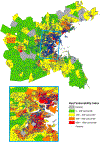Association of Area-Level Heat and Social Vulnerability With Recurrent Hospitalizations Among Individuals With Rheumatic Conditions
- PMID: 36071609
- PMCID: PMC9947700
- DOI: 10.1002/acr.25015
Association of Area-Level Heat and Social Vulnerability With Recurrent Hospitalizations Among Individuals With Rheumatic Conditions
Abstract
Objective: Climate and social vulnerability contribute to morbidity and health care utilization. We examined associations between the neighborhood Social Vulnerability Index (SVI) and the Heat Vulnerability Index (HVI) and recurrent hospitalizations among individuals with rheumatic conditions.
Methods: Using a Massachusetts multihospital centralized clinical data repository, we identified individuals ≥18 years of age with a rheumatic condition who received rheumatology care within 3 years of April 2021. We defined the index date as 2 years before the last encounter and the baseline period as 1 year pre-index date. Addresses were geocoded and linked by census tract to the SVI and the HVI. We used multilevel, multinomial logistic regression to examine the odds of 1-3 and ≥4 hospitalizations (reference = 0) over 2 years post index date by vulnerability index, adjusting for age, gender, race/ethnicity, insurance, and comorbidities.
Results: Among 14,401 individuals with rheumatic conditions, the mean ± age was 61.9 ± 15.7 years, 70% were female, 79% White, 7% Black, and 2% Hispanic. There were 8,251 hospitalizations; 11,649 individuals (81%) had 0 hospitalizations, 2,063 (14%) had 1-3, and 689 (5%) had ≥4. Adjusting for individual-level factors, individuals living in the highest versus lowest SVI areas had 1.84 times higher odds (95% confidence interval [95% CI] 1.43-2.36) of ≥4 hospitalizations. Individuals living in the highest versus lowest HVI areas had 1.64 times greater odds (95% CI 1.17-2.31) of ≥4 hospitalizations.
Conclusion: Individuals with rheumatic conditions living in areas with high versus low social and heat vulnerability had significantly greater odds of recurrent hospitalizations. Studies are needed to determine modifiable factors to mitigate risks.
© 2022 American College of Rheumatology.
Figures
Similar articles
-
Association of historical redlining and present-day racialised economic segregation with health-care utilisation among individuals with rheumatic conditions in Massachusetts and surrounding areas of the USA: a retrospective cohort study.Lancet Rheumatol. 2025 Jan;7(1):e33-e43. doi: 10.1016/S2665-9913(24)00235-2. Epub 2024 Nov 19. Lancet Rheumatol. 2025. PMID: 39577450
-
Examining Associations Between Neighborhood-Level Social Vulnerability and Care for Children With Sleep-Disordered Breathing.Otolaryngol Head Neck Surg. 2022 Jun;166(6):1118-1126. doi: 10.1177/01945998221084203. Epub 2022 Mar 8. Otolaryngol Head Neck Surg. 2022. PMID: 35259035 Free PMC article.
-
Social Vulnerability Index and Surgical Management of Abnormal Uterine Bleeding in Reproductive-age Women.J Minim Invasive Gynecol. 2022 Sep;29(9):1104-1109. doi: 10.1016/j.jmig.2022.06.003. Epub 2022 Jun 9. J Minim Invasive Gynecol. 2022. PMID: 35691547
-
Social vulnerability and traumatic brain injury hospitalizations from sports and recreation among pediatric patients in the United States.Ann Epidemiol. 2024 May;93:19-26. doi: 10.1016/j.annepidem.2024.03.002. Epub 2024 Mar 18. Ann Epidemiol. 2024. PMID: 38508406
-
Association Between Social Vulnerability Index and Cardiovascular Disease: A Behavioral Risk Factor Surveillance System Study.J Am Heart Assoc. 2022 Aug 2;11(15):e024414. doi: 10.1161/JAHA.121.024414. Epub 2022 Jul 29. J Am Heart Assoc. 2022. PMID: 35904206 Free PMC article.
Cited by
-
Multiplicative Impact of Adverse Social Determinants of Health on Outcomes in Lupus Nephritis: A Meta-analysis and Systematic Review.Arthritis Care Res (Hoboken). 2024 Sep;76(9):1232-1245. doi: 10.1002/acr.25359. Epub 2024 Jun 23. Arthritis Care Res (Hoboken). 2024. PMID: 38693617 Free PMC article.
-
Environment, Lifestyles, and Climate Change: The Many Nongenetic Contributors to The Long and Winding Road to Autoimmune Diseases.Arthritis Care Res (Hoboken). 2025 Jan;77(1):3-11. doi: 10.1002/acr.25423. Epub 2024 Sep 27. Arthritis Care Res (Hoboken). 2025. PMID: 39228044 Free PMC article. Review.
-
American College of Rheumatology White Paper: The Effects of Climate Change on Rheumatic Conditions-An Evolving Landscape and a Path Forward.Arthritis Rheumatol. 2024 Oct;76(10):1459-1466. doi: 10.1002/art.42919. Epub 2024 Jun 4. Arthritis Rheumatol. 2024. PMID: 38751102 Free PMC article. Review.
-
Multicenter Study of Associations Between Area-Level Child Opportunity, Initial Disease Severity, and Outcomes Among Children with Lupus.Arthritis Care Res (Hoboken). 2025 Aug;77(8):965-974. doi: 10.1002/acr.25523. Epub 2025 Apr 14. Arthritis Care Res (Hoboken). 2025. PMID: 40091444
-
Social Determinants of Health Documentation Among Individuals With Rheumatic and Musculoskeletal Conditions in an Integrated Care Management Program.Arthritis Care Res (Hoboken). 2023 Dec;75(12):2529-2536. doi: 10.1002/acr.25174. Epub 2023 Aug 7. Arthritis Care Res (Hoboken). 2023. PMID: 37331999 Free PMC article.
References
-
- About Social Determinants of Health (SDOH). [cited 2022 March 7, 2022]; Available from: https://www.cdc.gov/socialdeterminants/about.html
Publication types
MeSH terms
Grants and funding
LinkOut - more resources
Full Text Sources
Miscellaneous



